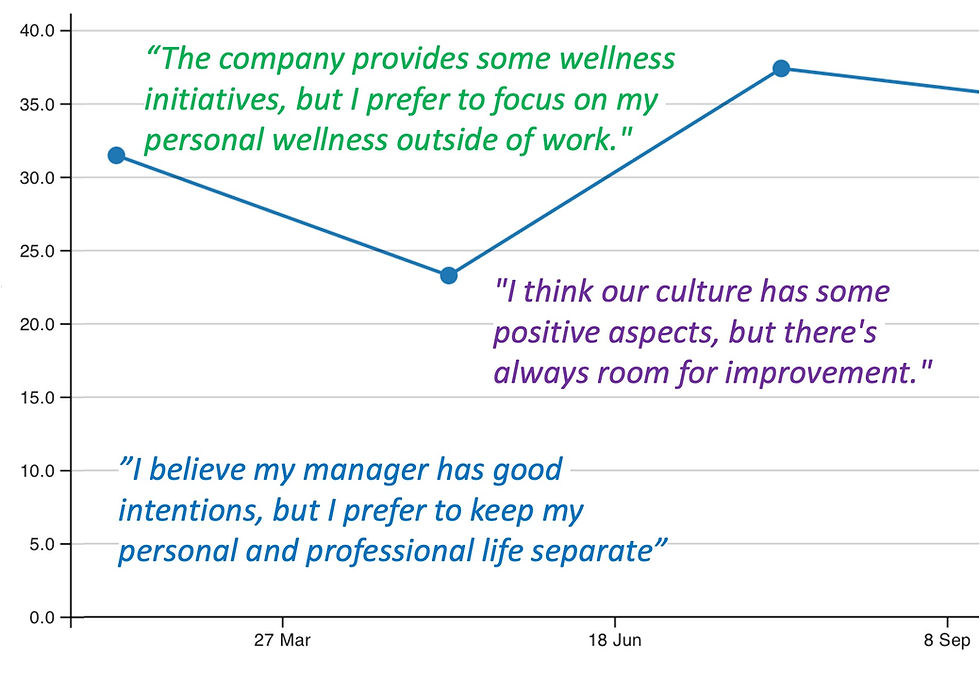Measuring the Language of Decision-Making: Fast vs. Slow Thinking
- Receptiviti

- Aug 6, 2024
- 4 min read
Updated: Aug 19, 2024
Have you ever wondered why some decisions feel effortless while others demand extensive contemplation? Imagine you're walking through a forest. You hear a rustle in the bushes. Instantly, your heart races and your mind leaps to thoughts of a lurking predator. This is your “System 1 thinking” at work – swift, automatic, and driven by your survival instincts. But then you remember you're in a city park. Your heartbeat slows as you rationalize the situation. This is your “System 2 thinking” – you’re now being more deliberate, logical, and methodical.

In his groundbreaking book, "Thinking, Fast and Slow," Daniel Kahneman, a Nobel laureate and one of the most influential psychologists of our time, introduced these two systems that govern our thoughts and decisions. In the 1970s, Kahneman and his collaborator Amos Tversky conducted a series of groundbreaking experiments that revealed how people often rely on heuristics (mental shortcuts) to make decisions, which often result in errors of judgment. Through their research, Kahneman and Tversky began to see a pattern whereby people often use two different modes of thinking:
Fast Thinking, also called System 1 thinking, is fast, intuitive, effortless, and it operates automatically, with little or no voluntary control. For example, when you recognize a friend’s face in a crowd, or instinctively catch a ball that is thrown at you, and when you hear someone say, “peanut butter and...". Because Fast thinking actions require almost no conscious thought, it is incredibly efficient for making quick decisions based on patterns and experiences. However, it’s also prone to biases, errors, the reliance on stereotypes and gut feelings, and can lead us to jump to conclusions.
Slow Thinking, also called System 2 thinking is a slow, analytical, and effortful thinking process. For example, you use Slow thinking when you solve a complex math problem, plan a trip, or write an article. It’s the thinking process that is activated when you need to focus, reason, and deliberate. Slow thinking allows us to be skeptical and question our instinctive assumptions, but because it demands more mental energy, we often default to Fast thinking unless we consciously override it.
The interaction between Fast thinking and Slow thinking influences our perception of the world and the decisions we make. Fast thinking is like autopilot, guiding us through routine tasks and quick judgments. Slow thinking is when our manual control takes over and we need to think things through more carefully. These two styles of thinking, called the Dual-Process Theory, is widely accepted as a foundational psychology concept for understanding human cognition, and provides valuable insights into how people think, make decisions, and behave.
Measuring Fast and Slow Thinking to Enhance Marketing Strategies
The ability to measure Fast and Slow thinking provides marketers with crucial insights into consumer decision-making processes. By understanding when consumers are relying on fast, intuitive judgments versus slow, deliberate evaluations, marketers can tailor their strategies accordingly. For example, if data reveals that a significant portion of a target audience responds quickly to emotional or visual stimuli, marketers can design campaigns that leverage striking visuals and emotional appeals to capture immediate attention. Conversely, if the data shows that consumers engage in detailed analysis before making a purchase, marketers can focus on providing comprehensive information, clear comparisons, and detailed product benefits. This nuanced approach allows for more effective targeting, ensuring that marketing efforts resonate with both intuitive and analytical decision-makers.
Measuring Fast and Slow Thinking to Transform Organizational Behaviour
For those focused on human capital and organizational behaviour, measurement of Fast and Slow thinking can enhance employee assessment by providing a deeper understanding of how employees approach tasks and make decisions. It can also help with improving corporate communication strategies by understanding when employees are likely to rely on intuitive, quick judgments versus when they engage in more deliberate, analytical thinking. For instance, if employees tend to react quickly to new information, presenting key messages in a straightforward, impactful manner can be more effective. On the other hand, if employees are likely to deliberate and analyze information thoroughly, providing detailed explanations and supporting data can facilitate better decision-making. By aligning management strategies with these cognitive processes, organizations can enhance employee engagement, streamline communication, and support more effective decision-making and problem-solving across the board.
Enhancing Talent Assessment by Measuring Fast and Slow Thinking
Measuring fast and slow thinking can greatly enhance talent assessment methods by providing insights into an individual’s cognitive processes and decision-making styles. In leadership contexts, fast thinking reflects an individual's ability to quickly process information and make rapid decisions, which is crucial in dynamic, high-pressure environments. In contrast, slow thinking reflects a capacity for thorough evaluation and strategic planning. By assessing an individual’s propensity for fast versus slow thinking across various situations, organizations can predict their future behavior and decision-making tendencies. For instance, an executive who predominantly uses slow thinking might be highly methodical but could benefit from leveraging intuition for routine decisions. Understanding these tendencies can help with the tailoring of roles to fit cognitive styles, thereby optimizing the individual’s performance. As a result, organizations can more effectively align talent with their strategic needs, boost productivity, and enhance decision-making processes.
Measuring Fast and Slow Thinking with the Receptiviti API
We are excited to announce the launch of our new Fast and Slow thinking Index, available through our API, that assesses both Fast and Slow thinking processes by analyzing a person's language. As part of our commitment to offering unparalleled insights into human psychology from language, our Fast and Slow thinking Index enables you to understand when individuals rely on intuitive, rapid judgments (Fast thinking) versus when they use deliberate, analytical reasoning (Slow thinking).



























